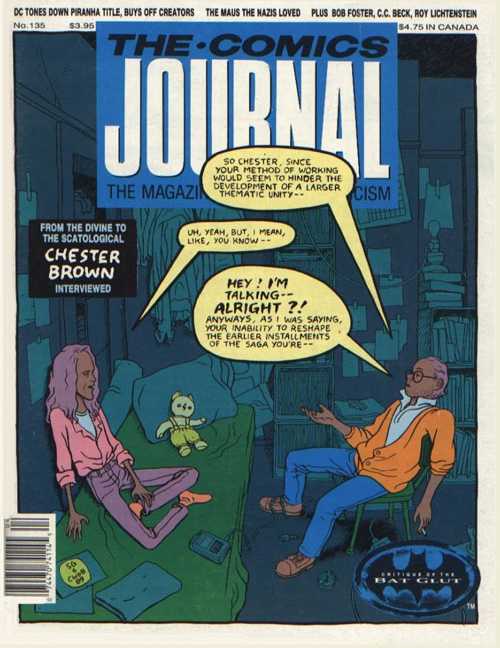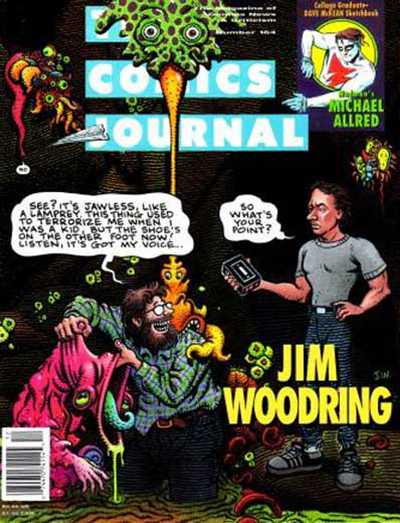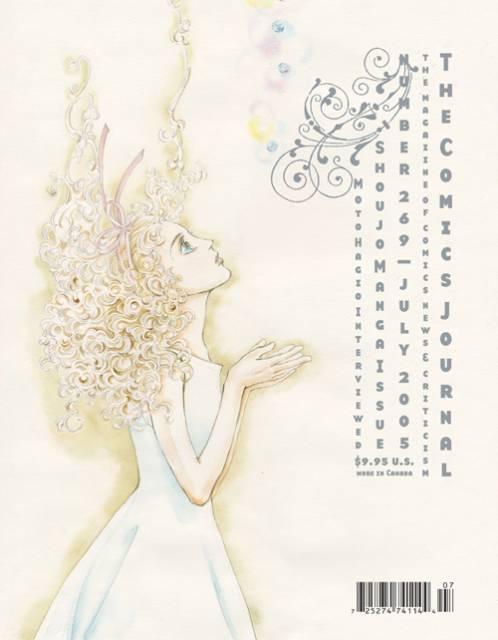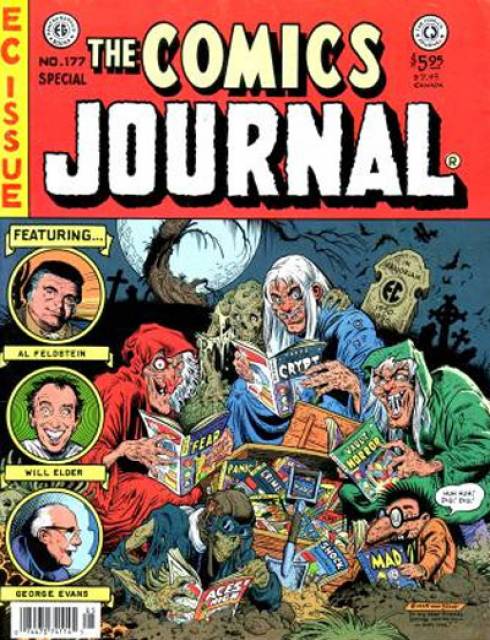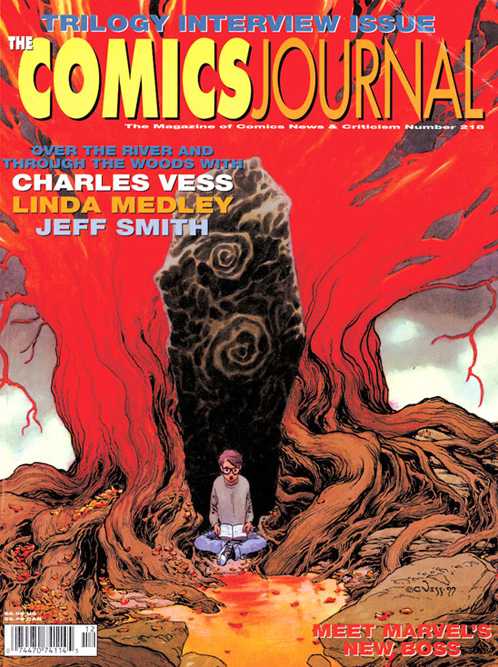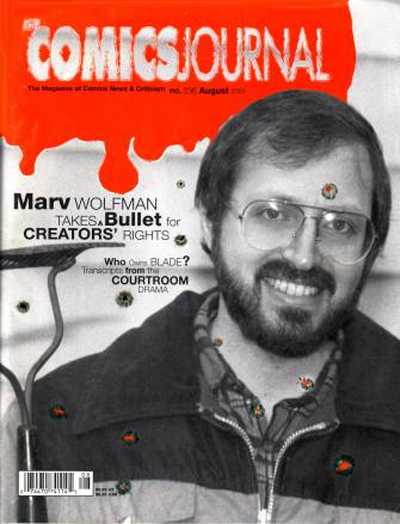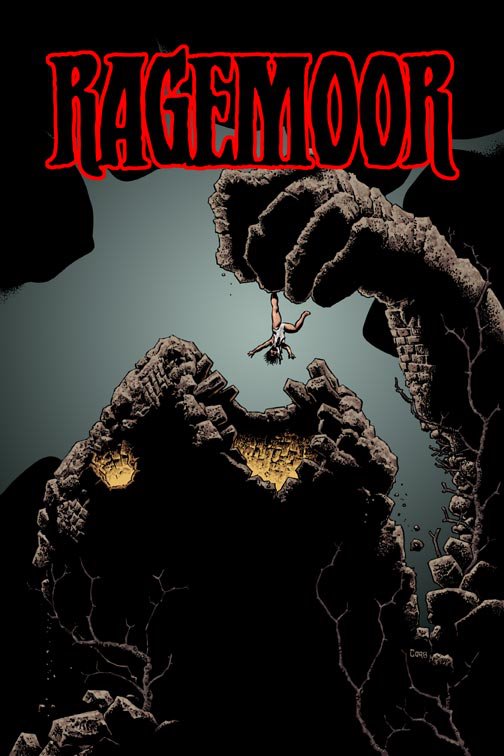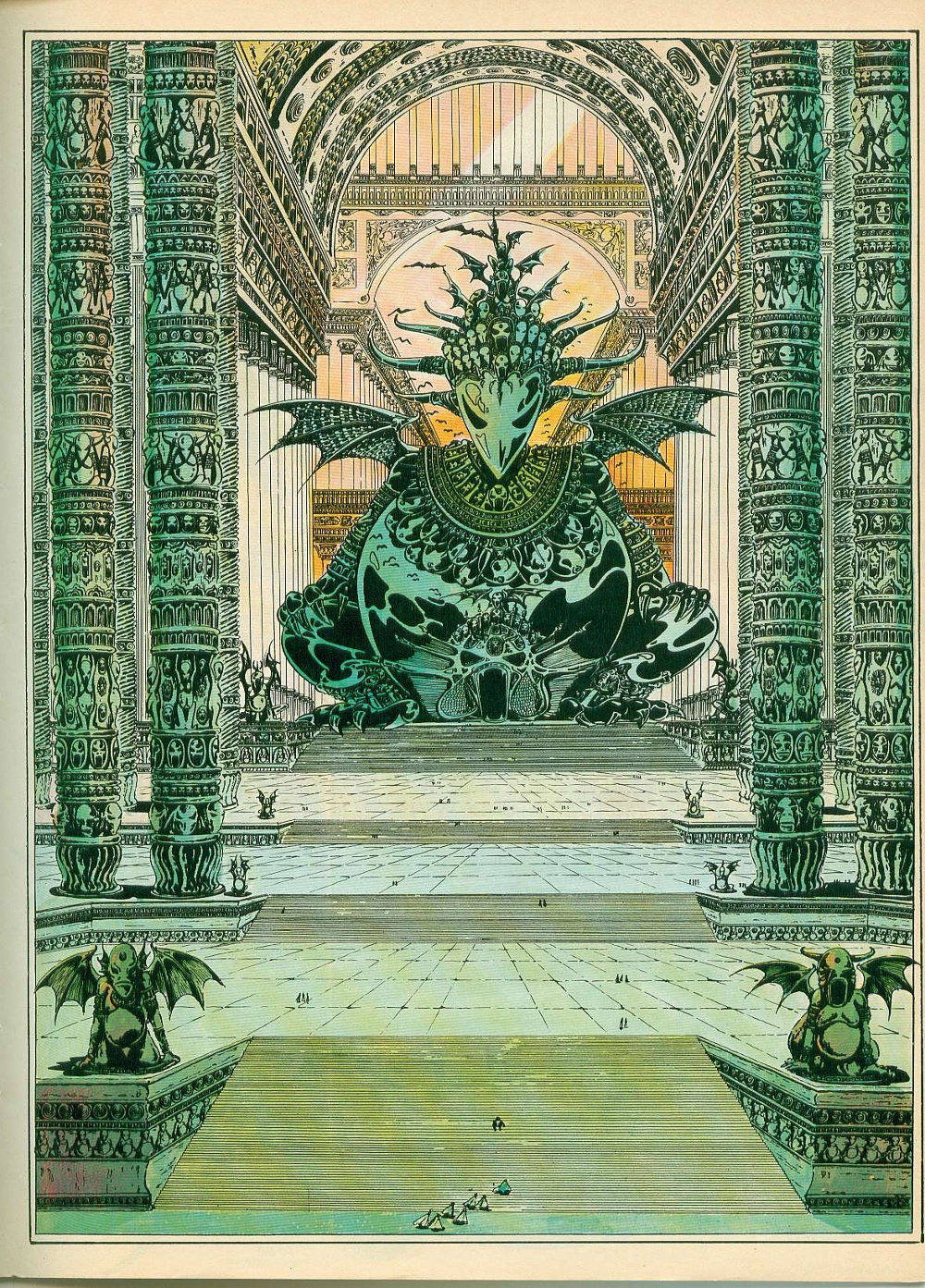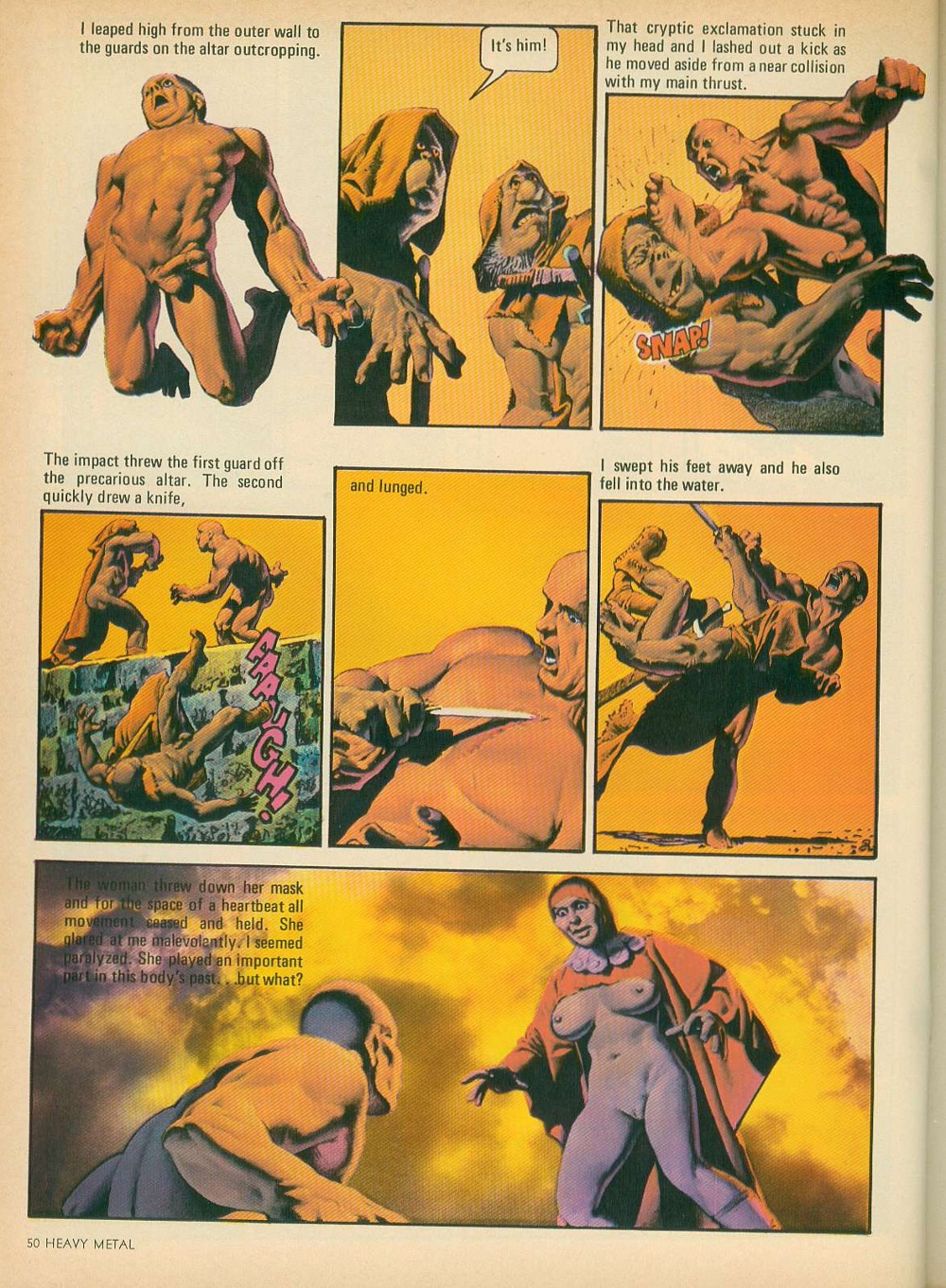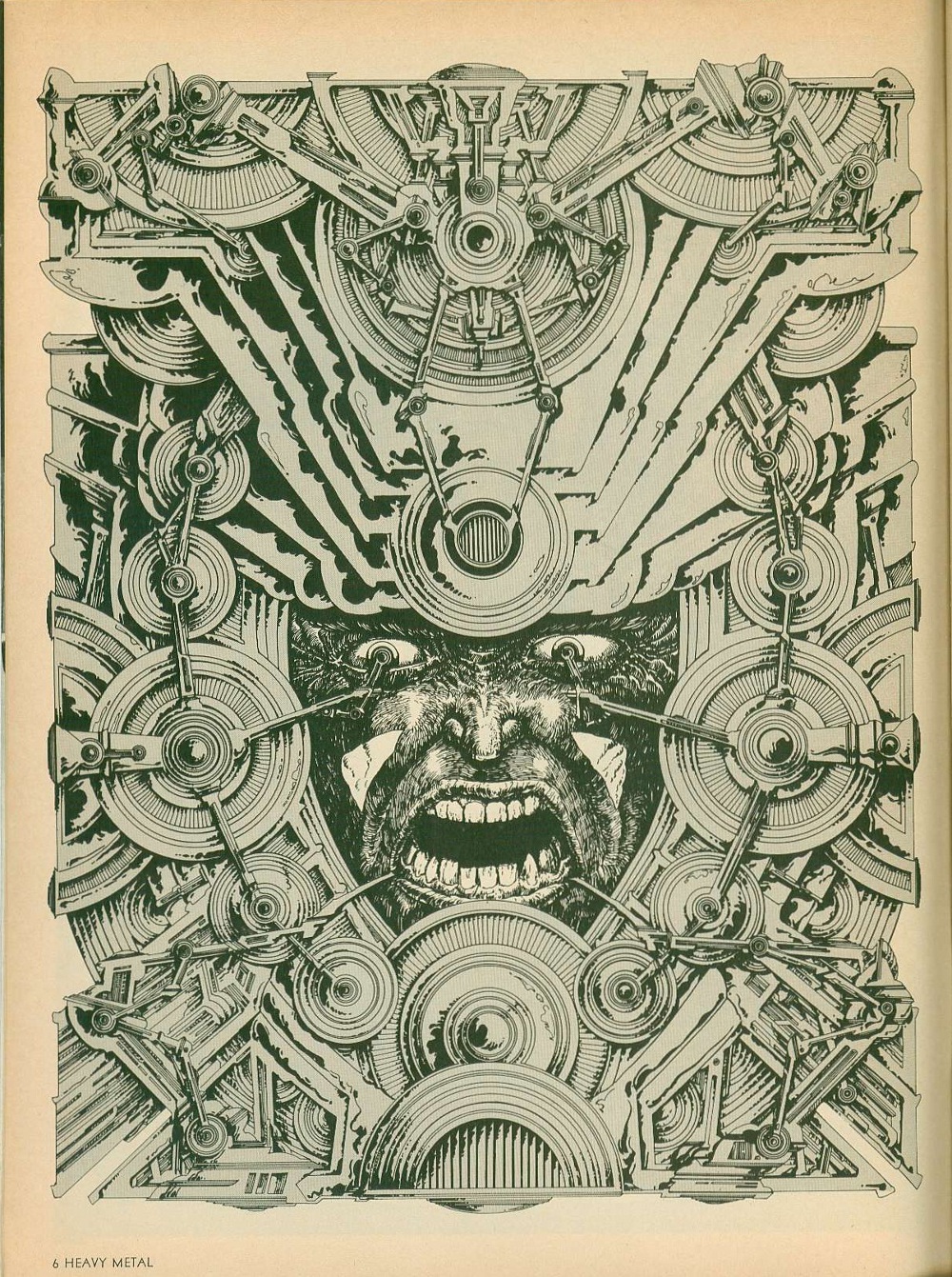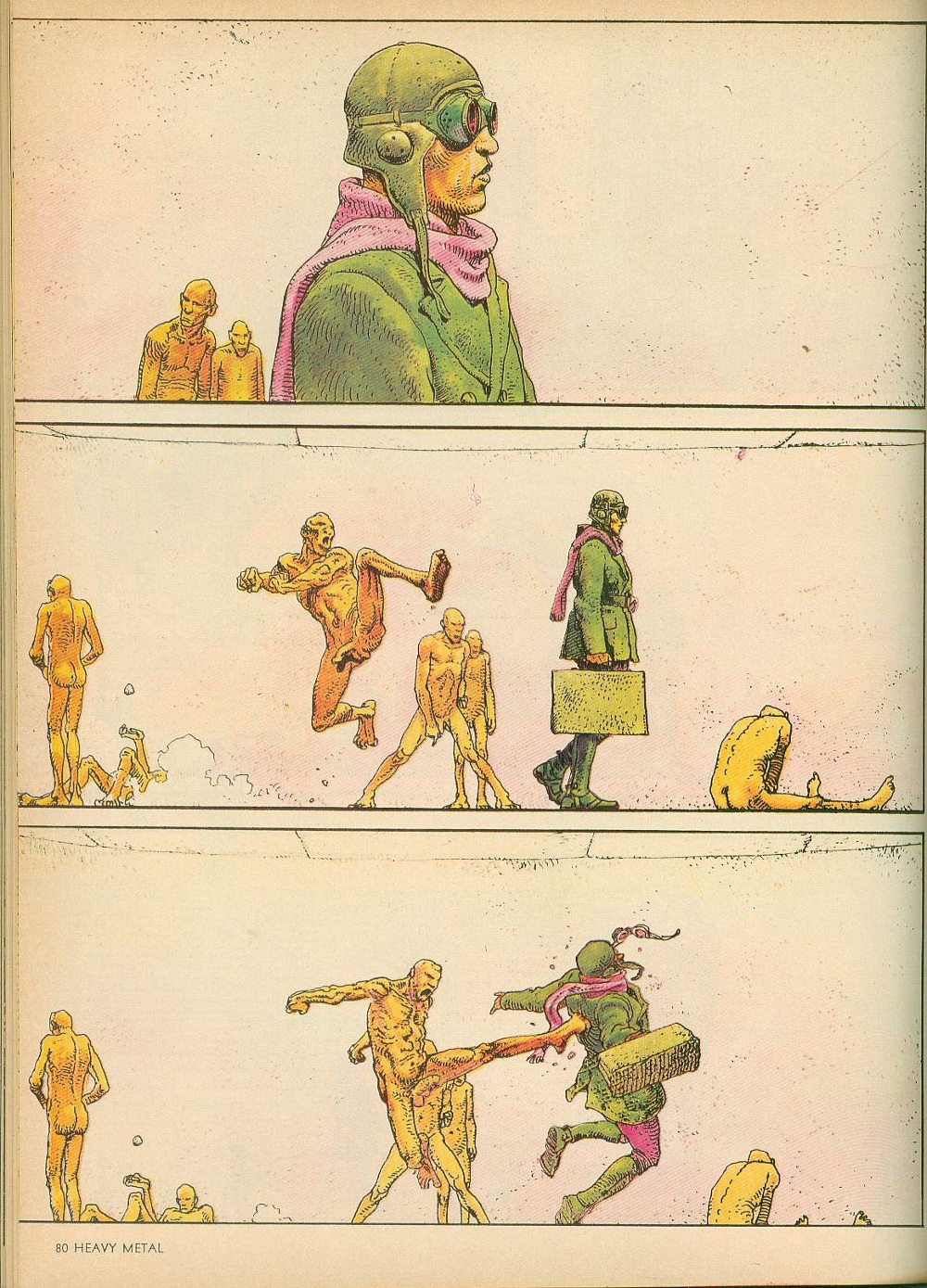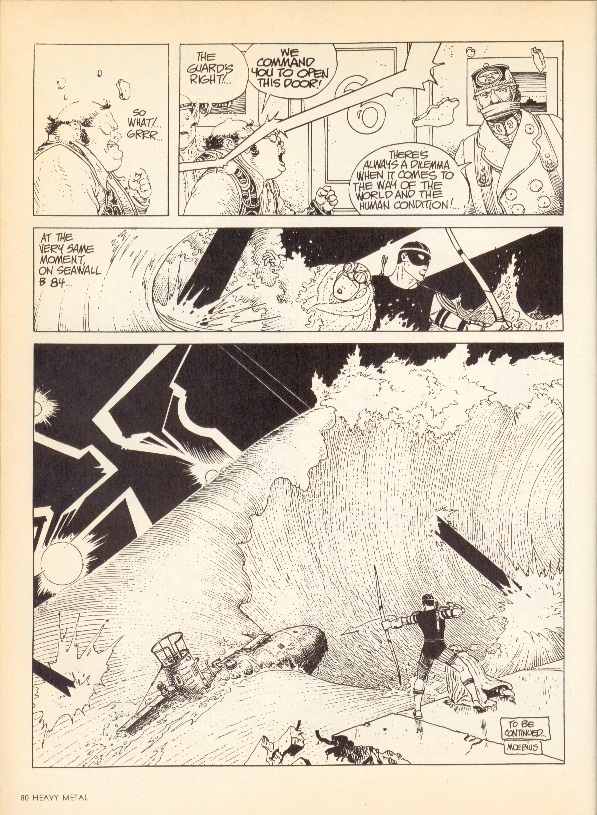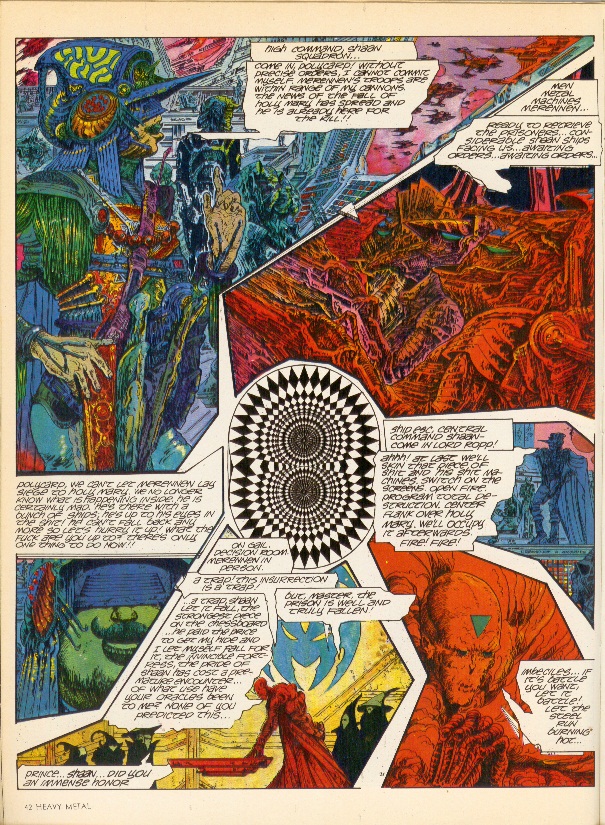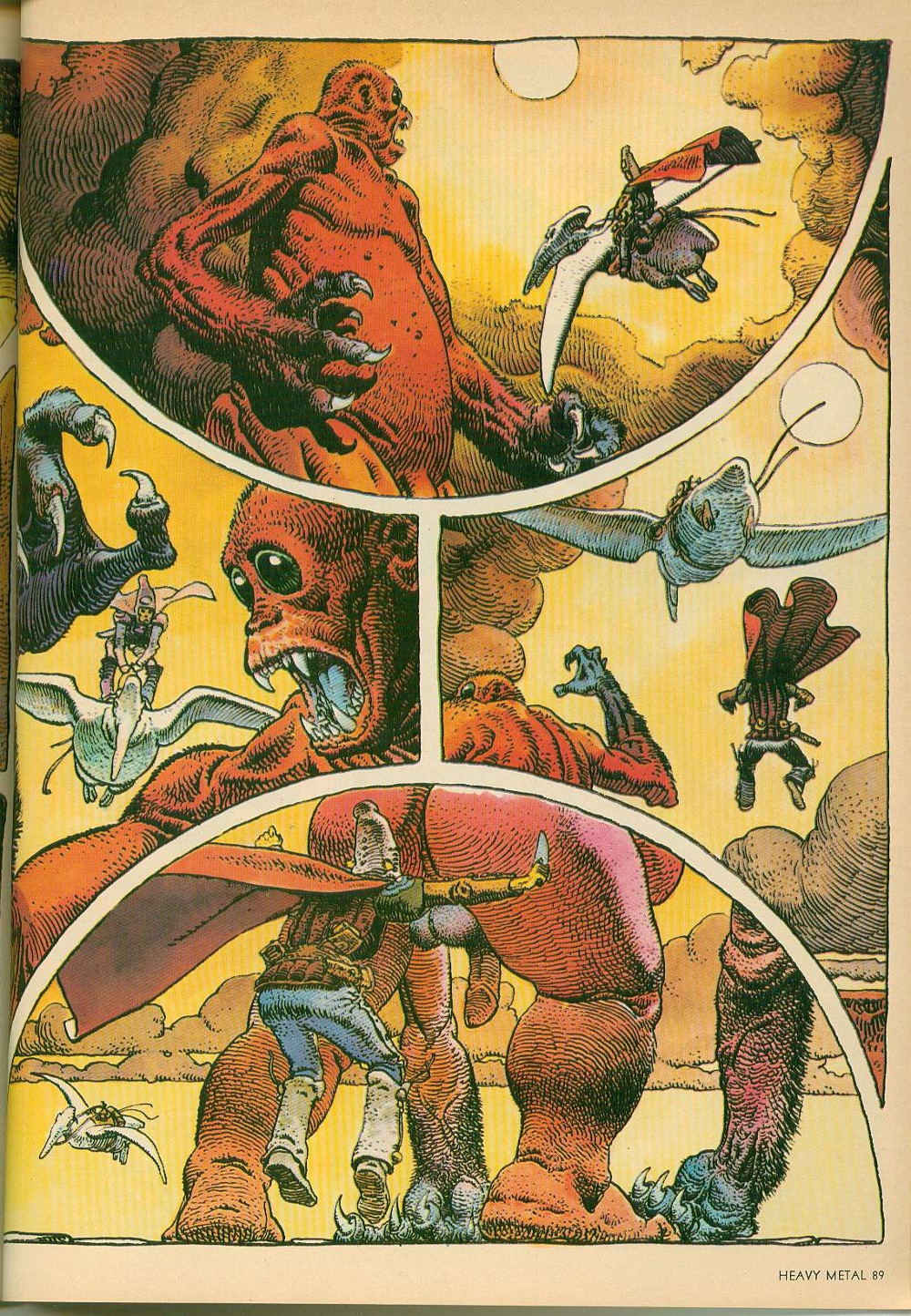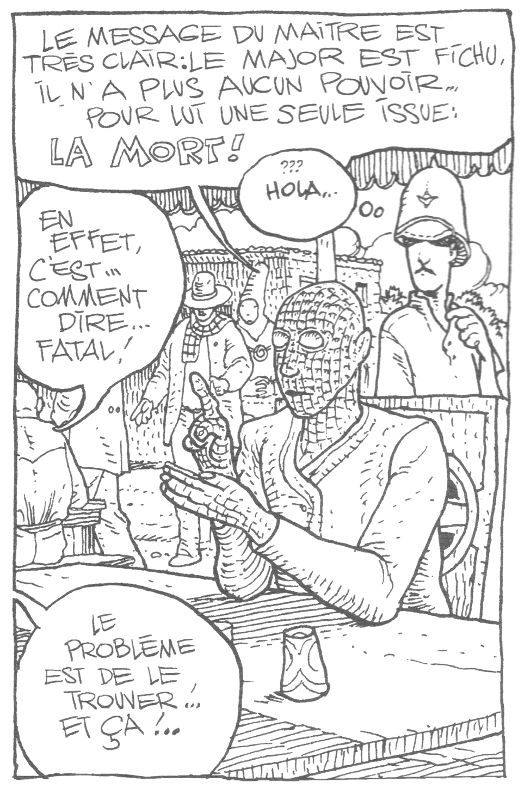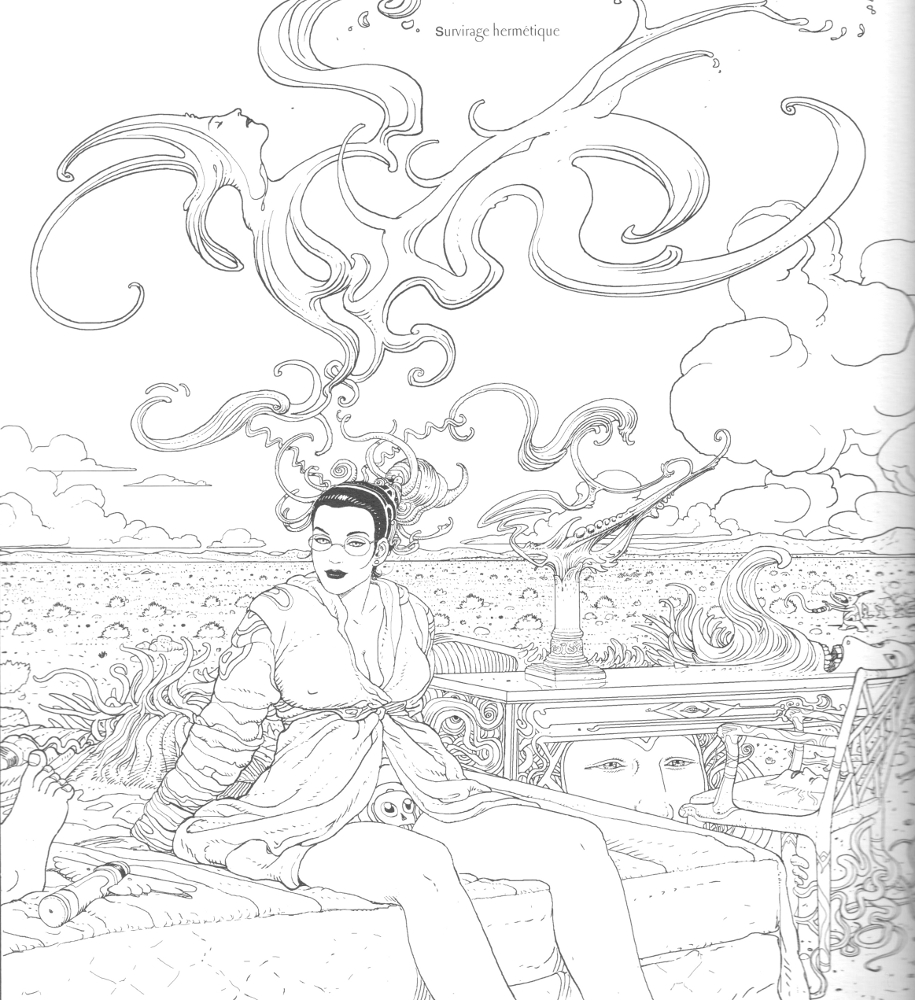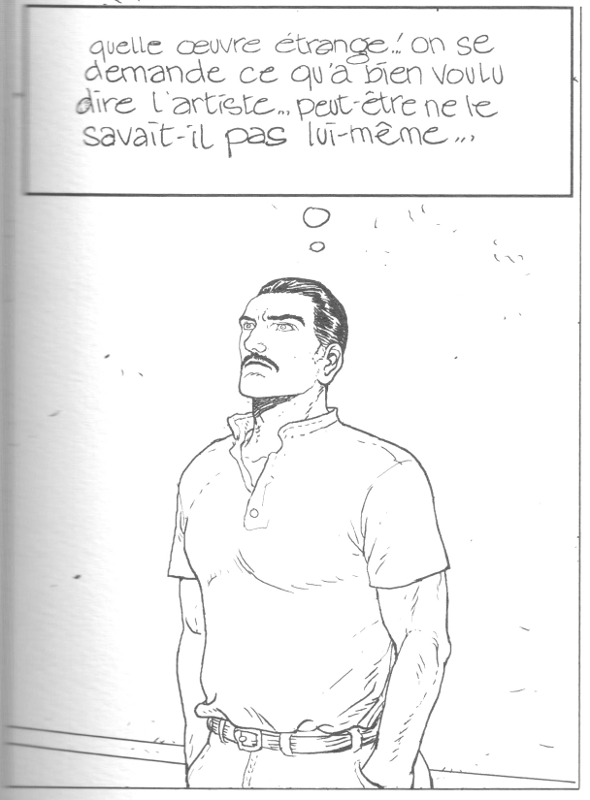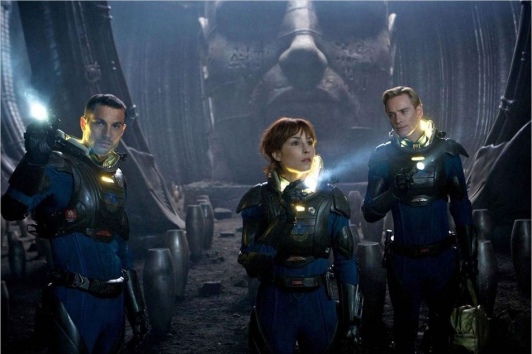
Logan Marshall-Green, Noomi Rapace, and Michael Fassbender in Prometheus
So I’d spent that June 1985 afternoon laying parquet in the future dance-rehearsal room of our Montmartre theater — a quixotic and doomed venture that consumed me and my compadres for two years. The parquet tiles were affixed to the concrete floor by a particularly noxious glue, and I foolishly wore no mask; after two or three hours, my nausea had built up to the point of copious vomiting. So I headed home, expecting the effects to dissipate with rest.
But the nausea continued, for the next three days. I was not only unable to hold down food, but water as well. On the afternoon of the third day I staggered into a clinic, hoping for some healing nostrum to take home — and was immediately hospitalised, with surgery scheduled for the next day; I had appendicitis, which had led to peritonitis and sepsis; my body was poisoning me.
That night, as I lay in bed with a saline drip attached to my arm to reverse my extreme dehydration, I experienced for the first time delirium. It was by no means unpleasant. A haze of uncertain time and odd sensual waves, and curious mental fugues rippling through my consciousness.
And then suddenly that consciousness focussed. I was living the life of a soldier in the Napoleonic period, seemingly cursed to face across the years a mad adversary in duels, wielding rapier, saber, pistol…the intensity of the hallucination was incredible.
Of course, it was no hallucination. The hospital room’s TV was showing director Ridley Scott‘s first feature film, The Duellists, and my fever had thrust me into it.

Ridley Scott directing Keith Carradine and Harvey Keitel in The Duellists (1977)
But how is it that my fever dream never delivered me that same hallucinatory re-incarnation via any of the other TV shows and dramas I watched that night?
Well, ‘fever dream’ is the answer, because fever dreams are what Scott creates at his best, what he seduces us into.
Ridley Scott has always been among the most visually-oriented directors; he studied at the prestigious Royal College of Art in London, and began his career as a set designer for the BBC. An excellent draftsman himself, he exercises over the art direction of his films an almost maniacal attention to visual and aural detail.

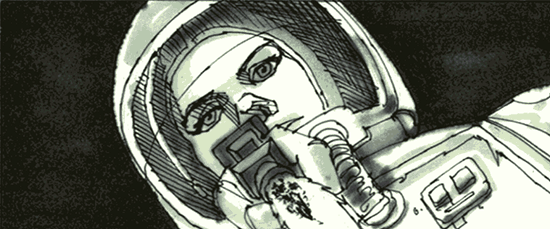
Storyboard drawings by Ridley Scott for Alien
This was apparent from his days as an extremely successful director of commercials; nobody who lived through the seventies in Britain (such as I) has forgotten his series of ads for Hovis bread. (Click through for video.) Observe the lushness of the photography and the thorough recreation of a period, hear Dvorak’s 9th Symphony hypnotise you into sentimental yearning. One of these ads was recently voted Britain’s all-time favorite television advert.
At the same time, the bullshit quotient of these commercials was high (what– bullshit in advertising? Stop the presses). Hovis is an admirable and healthful wholewheat bread, but it is, and has been from the start, an industrial product, not the loving fruit of the local artisanal baker’s craft. The golden glow of nostalgia radiating from these commercials is rooted in an imaginary past: the Depression-era North and Midlands of England were grim places indeed; besides, working-class and lower-middle class Englishwomen traditionally baked their own bread well into the sixties. A loaf of Hovis factory bread would’ve been regarded as a luxury.
Still, we willingly let ourselves be lulled by Scott’s dreamweaving. And I maintain that this holds true not just for his ads, but also for Scott’s most successful films. They are often riddled with logical and narrative incoherency, leave questions unanswered and mysteries unresolved– we don’t care. We want the fever dream.
Scott’s great talent is for the creation of plausible worlds. Note: I say plausible, not realistic or even believable. He can create a romanticised Napoleonic age (The Duellists) or an outrageously baroque Roman Empire (Gladiator); an exoticised techno-Orientalist modern Tokyo (Black Rain); a fairy-tale land (Legend); the science-fictional Earth of Blade Runner and Space of Alien; and we are there with him. Because we want to be!
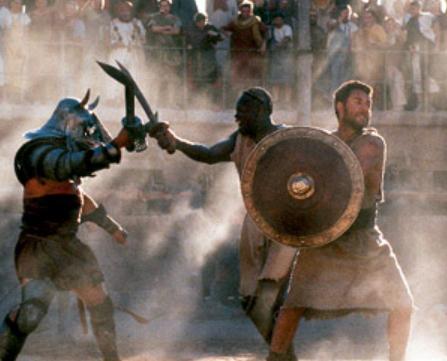
From Gladiator. Note the dust; Scott uses (abuses?) dust and mist lavishly for visual oomph
As a sample of this world-building prowess, consider his famous 1984 Superbowl commercial introducing the Apple Macintosh computer. (Click through for video.) Although it only ever aired once, its impact was extraordinary and resounds down to this day. What we note, behind the rather perfunctory and obvious allegory, is Scott’s skill at implying an entire imaginary world in so brief a span of time.
Scott’s breakthrough film was, of course, Alien in 1979.
It manages a) to show one of the most believable science-fiction worlds ever presented on the screen, and b) to be one of the most frightening movies ever made.
The first is due to Scott’s aforementioned obsessive attention to detail and visual talent. The second is due to his genius for emotional manipulation.
Alien benefited hugely from Scott’s discernment of artistic talent. It’s been said dismissively of him that as a director, he made a great art director; but an art director’s brilliance made the film.
His great coup was to recruit the artist of the grotesque, H.R.Giger, to design the alien monster and the extraterrestrial ruined spaceship.
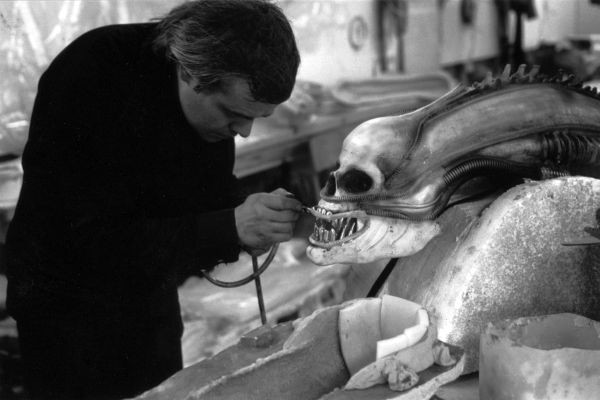
H.R.Giger building the alien
Other marvellous talents were recruited for other aspects of the film, cast like actors; Ron Cobb designed the Earthling spaceship Nostromo, and Jean ‘Moebius’ Giraud designed the spacesuits.
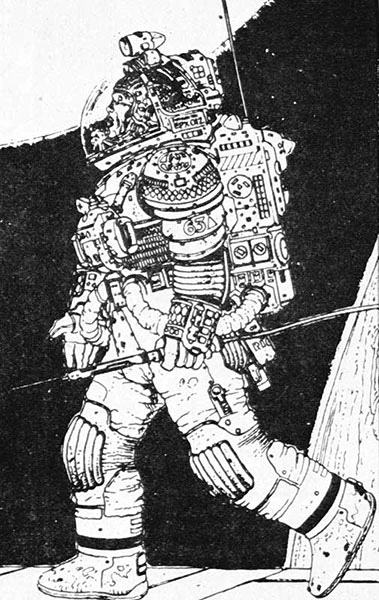

Above: Giraud’s spacesuit design. Below: the suits as seen worn among Giger’s set.
Scott’s gift for manipulation — his dark side, as it were — told him the most effective ways to induce fear and horror. Alien features a nightmarish view of the body’s flesh and fluids. In addition to the usual directorial tools of suspense and pacing, the whole Hitchcockian array, Scott very consciously reaches for the visceral and the subconsciously somatic gripping to create his nightmare.
After Alien, Scott’s science-fiction follow-up was Blade Runner (1982), an adaptation of Philip K.Dick’s Do Androids Dream of Electric Sheep? This was another visual triumph, with Scott again partnering with a design visionary, Syd Mead.
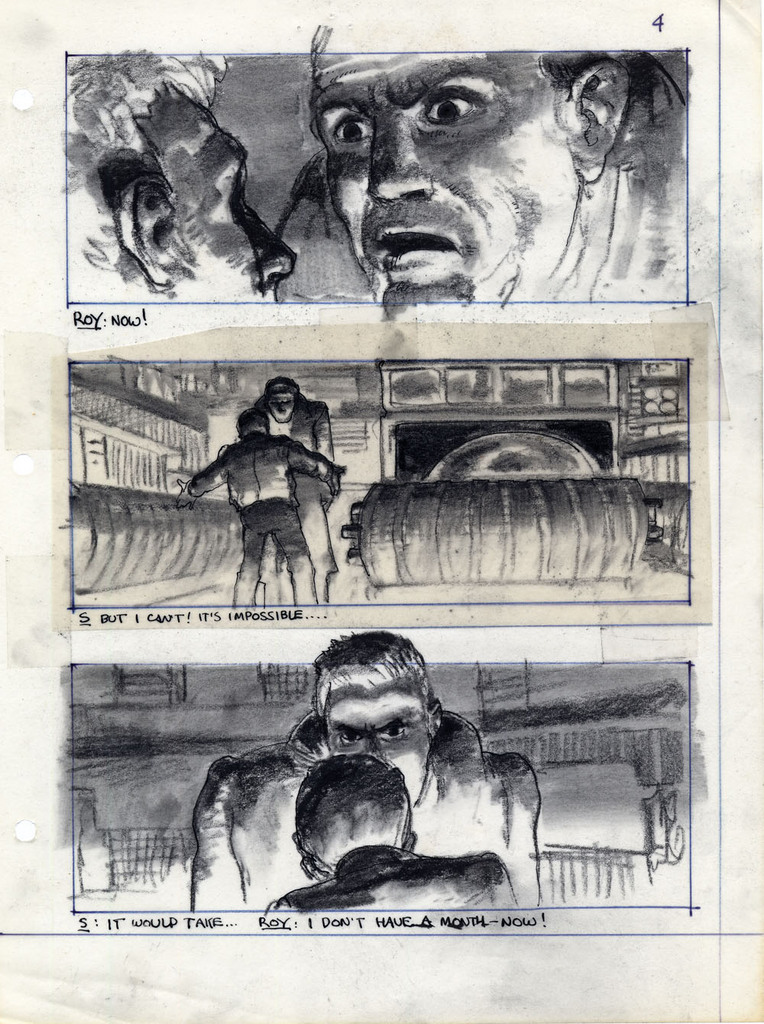
Storyboard from Blade Runner, drawn by Ridley Scott
At the time, Scott declared that the science-fiction film needed its John Ford — that is, a director who could be to the SF genre what Ford was to the Western. And Scott could have well fit the role.
But thirty years passed before he made another science-fiction film: Prometheus.
**********************************************************
Scott’s career during this hiatus soared, creating gems (Thelma and Louise, Gladiator, Black Hawk Down) and duds (Someone to Watch Over Me, G.I.Jane.) The initial box-office failures of Blade Runner and of Legend may have caused him to shy away from the fantastic. He was also vocally displeased with the rather ham-fisted exploitation, by other hands, of the Alien franchise. However, for the past ten years he has been working on a prequel to Alien — only to shy away from that notion in recent years, at least in public.
His and the studio’s coyness about Prometheus has exasperated fans. Is it or isn’t it a prequel?
To answer that question, I was, in the evening of June 1st, Prometheus bound. (Sorry, couldn’t resist.)
So the answer to “is this an Alien prequel” is…?
Yes.
And no.
Yes, for it fits perfectly into the Alien universe, Giger designs and all. No, because the film works perfectly well as a stand-alone. Scott has his cake and eats it; good for him.
Is it a good film? Yes — but only if you are willing to embrace the fever dream — the nightmare. By which I don’t exactly mean the old cliché “check your brain in at the box office and enjoy”.
Science fiction is the most cerebral of genres; but it also works with the unreasoning emotions of awe, wonder and horror — with the sublime. The latter are this film’s strong suits.
Now I want this article to be relatively spoiler-free, so I won’t go into plot details. But, for any savvy SF aficionado, there’s nothing conceptually new on offer here. Von Daniken and Lovecraft seem to be the main inspirational motors. (Lovecraftians will understand this allusion: where Stanley Kubrick’s 2001:A Space Odyssey has been called a shaggy God story, one could call Prometheus a shoggy God story.) The old SF trope of mankind having been seeded on Earth by extraterrestrials has long since run into the problem of Homo Sapiens‘ close genetic kinship with other primates such as chimpanzees and gibbons; to my knowledge, only the writer Larry Niven has worked his way around this inconvenient fact, in his novel Protector. The film ignores this.
There are numerous logical lapses, not just in concept, but in motivation and continuity. The strong, simple storyline of Alien here is complicated by a larger cast and fussy mise-en-scène– people go from ship to ruins to ship to ruins to ship and from chamber to tunnel to chamber to tunnel until the viewer has no sense of place. Many of the characters are stereotypes.
But, you know what? None of these objections amount to much. Let your reptile brain take over, give in to the Scottian dream.
The nightmare works more powerfully than ever off our deep revulsions for the flesh, our imaginative perversions of sex, birth, death, and animality. We are fed one particular abomination that is the ultimate in vaginadentatatentaclepornhermaphroditicmisogynist monsters: it makes the cosmic squid in Watchmen look like a wee twee fairy. This she-he-horror fights its opposite number, an extraterrestrial superphallic Uebermensch, and succeeds in raping him in true classic Alien style. With the usual, unholy, parturient result.
But the most harrowing sequence has one of the female characters, impregnated with an atrocity waiting to burst through her abdomen, racing to have an automated robot surgery pod operate an emergency caesarian/abortion. The extracted monster is a squealing, squirming betentacled mass of boneless flesh, held in the sterile metal grip of the robosurgeon.
Beyond the hideous delights of this sequence, I find it well encapsulates the genesis of Prometheus. We, the audience, are the woman. Inside us resides the secret monster of our Id. Ridley Scott is the robosurgeon, who clinically, mechanically extracts the creature and shows it to us: the creature being, of course, the film.
Some final random notes: the acting level is uniformly above par; great pleasure is derived from Michael Fassbender‘s alternately childlike and malevolent android Dave. He provides an incarnation of the Superego– sandwiching the humans between himself and the Id of the monsters.
This is definitely a star-making turn for Noomi Rapace, as protagonist scientist Elizabeth Shaw. Strength and vulnerability, emotion and will to knowledge, are complexly communicated by her wonderfully expressive features.
Charlize Theron plays yet another ice-queen bitch. Disturbingly, the trailer before the film was for Snow White and the Huntsman, where she plays yet again another ice-queen bitch. Lady better watch out for the stereotype patrol.
The visuals are predictably stunning, and this is one of the very few 3D films I’ve seen that justifies the extra price.
So: welcome to his nightmare, and to yours. Go see it.
++++++++++++++++++++++++++++++++++++++++++++
Scott is not alone in this club of visualists/dreamers. I would group him with Tim Burton, Terry Gilliam and Jean-Pierre Jeunet (all four being graphic artists originally) as cinematic visionaries who triumph over weak story to enthrall us with their worlds; the distant children of Georges Melies.
(In comics, I place Jack Kirby, Steve Ditko, Rick Griffin and Jean Giraud in the same family.)
Still, it should be pointed out that these directors do their best work with quality scripts: The Fisher King for Gilliam, Alien and Thelma and Louise for Scott, Beetlejuice and Big Fish for Burton. And other visualists, such as Jean Cocteau, Stanley Kubrick or David Fincher, have always worked both hemispheres of the brain — investing just as much energy into the writing as into the dreaming. Scott himself has evolved in this direction.
May he continue to do so; he is currently developing a sequel to his other SF masterpiece, Blade Runner. And Prometheus ends with the possibility of a grandiose sequel.
Perhaps science-fiction will have its John Ford, after all.
++++++++++++++++++++++++++++++++++++++++++++
Silly P.S. # 1:
Noomi Rapace was discovered as the star of the Swedish version of The Girl with the Dragon Tattoo, in which she played Lisbeth Salander. The American version stars Rooney Mara.
Those are three cool names!
Silly P.S. #2:
In 1977, I clipped a pretentious review of ‘The Duellists’ and sent it to the Pseud’s Corner column of the satirical magazine Private Eye. They sent me back a cheque for five pounds sterling, enough for a nice dinner at Hamburger Delight.
Thanks for the burger, Ridley!
+++++++++++++++++++++++++++++++++++++
Check out this site for the corporate villainy behind the voyage of the Prometheus
A marvelous blog of science-fiction and fantasy art :






